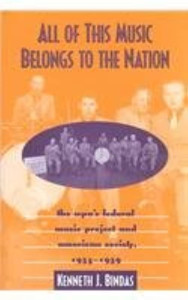 The Federal Music Project was designed in 1935, as a part of the Works Progress Administration (WPA), to employ musicians who had been hard-hit by the Great Depression. (Roosevelt’s social programs formed a model for similar Canadian programs that are on-going to this day here in the northland.)
The Federal Music Project was designed in 1935, as a part of the Works Progress Administration (WPA), to employ musicians who had been hard-hit by the Great Depression. (Roosevelt’s social programs formed a model for similar Canadian programs that are on-going to this day here in the northland.)
The history of Roosevelt’s experiments in supporting art, literature and theatre has been fairly well documented. Tim Robbins’ recent film And the Cradle Will Rock portrayed Orson Welles’ experience, and gave a glimpse of Mexican muralist Diego Rivera’s WPA involvement. Some remarkable pieces of art were created through the support of the WPA. Kenneth J. Bindas documents a little-known aspect of the program.
The Federal Music Project (FMP) was more conservative than the corresponding projects in the other arts. Its stated aim was to “raise the taste of musicians and citizens alike.” The FMP focussed on “cultured” music, specifically the works of European classical composers. However, many of the unemployed musicians the plan sought to help were popular players who filled the ranks of dance bands, jazz bands, and Tin Pan Alley’s “pop” music machine. Tension and dissatisfaction arose as some of these musicians who needed assistance were treated like second-class citizens. The American Federation of Music tried to force the FMP to help more “rank & file” musicians who were out of work. These “less serious” players were also penalized by lower salaries under the elitist plan of the program. Eventually, the FMP paid all musicians the same (except for music teachers, who received less).
The program seemed doomed to failure from the beginning, partly because a Russian classical musician, Nikolai Sokoloff, was put in charge of the project. His taste helped define the type of “cultured music” citizens and musicians were to be taught to appreciate, to the exclusion of more vernacular music. He formed a 25-member advisory committee to help implement the program. This committee included George Gershwin and Leopold Stokowski, among others.
Small- and large-scale concerts were organized for events as disparate as a parking lot opening and baseball games. Symphonic music was played at most of these events. The project’s theory was that “music has no social value unless it is heard.” While Sokoloff and his staff realized that “most Americans preferred the popular tunes available,” they felt that “if these same people were exposed to better music, they would naturally choose cultured music over popular music.” An interesting if elitist concept.
As with each of the individual projects in the WPA, the FMP had its successes and its failures. It was scaled up and scaled back as more or less money was available. Because of government manipulation and missteps, its successes were limited. The leadership of Sokoloff was perhaps the project’s weakest point. When asked how he felt about swing music “… – which was providing employment to many musicians and reviving a nearly dead recording industry – he responded, ‘I like to dance when I am dancing but to compare it with music, why it is like comparing the funny papers with the work of a painter.’ ”
Bindas explores the FMP’s mandates, leadership and strategies, and provides a clear history of the project and its times, as well as discussing its successes and failures. He makes judgments, and puts much of the responsibility clearly at the feet of the project’s administrators. For example, in a social program it is hardly surprising to find “socialist” sympathizers taking part; yet throughout the entire run of the WPA, whenever the socialist agenda appeared, it was seen as rampant communism and nipped in the bud.
The program closed after only four years, Sokoloff having resigned in 1938. Musicians had been employed, people had heard music, but the FMP was never the success Roosevelt hoped it would be. Bindas makes an interesting observation in his conclusion.
As it mirrored middle-class views concerning community involvement, Americanness, and quality music, the project distanced itself from those musical activities it deemed unworthy or common. The emphasis on cultured music, while noble and within the middle-class vision of both the New Deal and American consciousness, meant that the FMP could ignore the bulk of unemployed musicians who neither had the training nor the skill to perform classical compositions.
The FMP is a clear example of [muting the diversity of the American mosaic] and forms the core of the paradox of the 1930s, when individualism was held in high esteem, but conformity was rewarded.
All of This Music Belongs to the Nation is an interesting, if academic, look at a fascinating era in American history.
(University of Tennessee Press,1996)
